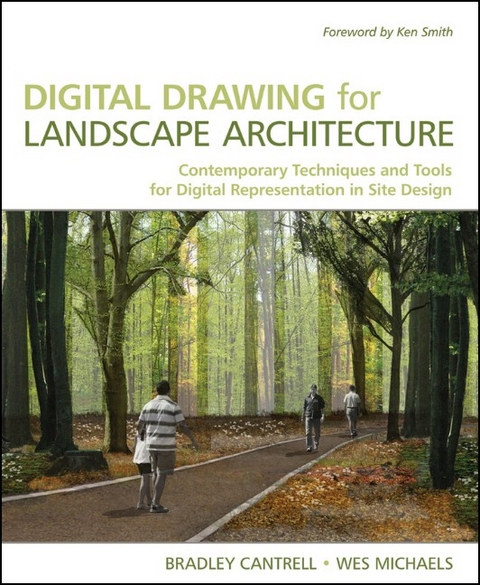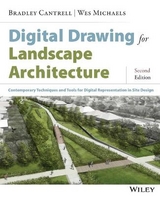
Digital Drawing for Landscape Architecture
John Wiley & Sons Ltd (Verlag)
978-0-470-40397-6 (ISBN)
- Titel erscheint in neuer Auflage
- Artikel merken
Digital Drawing for Landscape Architecture won the "Award of Excellence" from the 2012 Professional Awards and Student Awards by the American Society of Landscape Architects (ASLA).For a hundred years, pencil, pen, markers, and watercolor have been the principal tools of representation for landscape architects and urban planners. Today, those hand-powered aids have been replaced by computers and Computer-aided design (CAD). Digital Drawing for Landscape Architects bridges the gap between the traditional analog and the new digital tools and shows you how to apply timeless concepts of representation to enhance your design work in digital media.Building on the tried-and-true principles of analog representation, Digital Drawing for Landscape Architecture explores specific techniques for creating landscape design digitally. It explains the similarities and differences between analog and digital rendering, and then walks you through the steps of creating digitally rendered plans, perspectives, and diagrams.
You'll explore: * Computing Basics * Raster and vector images * Setting up the document * Base imagery and scaling * Hand-drawn linework and diagrams * Text, leaders, and page layout * Color, shading, and textures * Creating a section elevation * Perspective drawing * Techniques for using the newest versions of Adobe Illustrator, Photoshop, and Acrobat as well as older versionsWith more than 500 full-color drawings and photographs alongside proven techniques, Digital Drawing for Landscape Architects will help you enhance your skills though a unique marriage of contemporary methods with traditional rendering techniques.
Bradley Cantrell is Principal of and Partner in Visual Logic Inc. and a founding partner in LND Digital Workshop, digital media training and consulting. He is also Assistant Professor, School of Landscape Architecture, Louisiana State University. He received an MLA II from the Harvard University Graduate School of Design with a concentration in digital site representation and interactive spaces. Wes Michaels is a principal of Spackman+Mossop+Michaels Landscape Architects and a partner in LND Digital Workshop, digital media training and consulting. He is also an Assistant Professor of Landscape Architecture, Louisiana State University. He received an MLA from the Harvard University Graduate School of Design.
Foreword. Preface. Acknowledgments. Part 1: Concepts. Chapter 1: Introduction/Overview. Computing Basics. Hardware. Software. Workspace. Chapter 2: Analog and Digital Rendering Comparisons. Efficiency and Editability. Commonalities and Parallels. Hybrid Techniques. Chapter 3: Basic Overview of Digital Concepts. Raster-Based Programs. Resolution in Raster Images. Upsampling and Downsampling. Vector Images. Using Raster Images in Vector-Based Programs. Color. Chapter 4: Digital Drawings in the Design Process. Applications for Specific Tasks. Moving between Analog and Digital Techniques. Part 2: Base Imagery. Chapter 5: Setting up the Document . Drawings at Multiple Sizes. How Drawings Move through the Digital Workflow. Setting the Image Size. Chapter 6: Base Imagery and Scaling. Aerial Photography. Obtaining the Aerial Photograph. Tiling Aerial Photographs in Photoshop. Manual Method. Tiling Photographs with Photomerge. Scaling the Aerial Photograph. Calculator Method. Scale by Reference Method. Pixel Conversion Method. Adjusting the Hue, Saturation, and Lightness of Base Imagery. Using CAD Linework as a Base. Exporting the CAD Linework as a PDF. Chapter 7: Hand-Drawn Linework. Sketches in CAD. Using Magic Wand and Color Range Selections. Using the Color Range Selection Tool. Chapter 8: Source Imagery/Entourage. Selections. Manual Methods. Partial Selections. Part 3: Design Diagrams. Chapter 9: Introduction to Diagrams. Passive Diagramming. Active Diagramming. Communication. Abstraction. Distilling and Culling. Diagram Types. Chapter 10: Setting up an Illustrator Drawing. Document Size/Color Mode. Based Programs for Design Diagrams. Importing an Aerial Photo into Illustrator. Link versus Embed. Chapter 11: Linework in Illustrator. Shape Tools. Pen Tool. Editing Tools. Appearance of Lines and Shapes . Stroke Weight and Dashed Lines. Transparency. Appearance Palette. Chapter 12: Custom Linework. Creating a Pattern Brush from Shapes. Altering the Pattern Brush. Updating the Pattern Brush with New Shapes. Chapter 13: Symbols. Creating Symbols from Custom Artwork. Updating/Replacing Symbols. Managing Symbols. Creating Clipping Masks for Image Symbols. Chapter 14: Text, Leaders, and Page Layout. Text Tools. Point Text. Paragraph Text. Differences between Point Text and Paragraph Text. Formatting Text. Custom Type Tools. Creating Text with a Clipping Mask. Leaders. Effects versus Filters. Layout. Chapter 15: Exploded Axonometric Diagrams. Creating an Exploded Axonometric Diagram. Part 4: Plan/Section Renderings. Chapter 16: Introduction to Renderings. Design Process. Issues in Digital Media. Illustrative Components. Chapter 17: Importing PDF Linework. PDF Linework. Adjusting the Appearance of Linework. Chapter 18: Applying Color to a Plan Rendering. Technique 1: Applying Color with the Paint Bucket Tool. Technique 2: Applying Color Using Adjustment Layers. Saving Channels. Chapter 19: Shading Techniques. Selecting Fills. Saving Selections. Automating the Shading of Edges. Chapter 20: Creating Textures. Creating a Texture from an Existing Photograph. Creating a Seamless Pattern Using the Offset Filter. Creating the Pattern and Applying It to the Rendering. Paint Bucket and Pattern Stamp. Pattern Overlay. Managing Patterns. Texturing with Filters. Chapter 21: Brushes. Standard Brushes. Custom Brushes. Chapter 22: Plan Symbols with Smart Objects. Creating Smart Objects. Duplicating and Editing Smart Objects. Managing Smart Objects. Smart Filters. Chapter 23: Managing Large Photoshop Files. Flattening Layers. Saving Layer Groups for Flattening. Printing Issues. Chapter 24: Creating a Section Elevation. Methods. Part 5: Perspectives. Chapter 25: Perspective Illustration. Perspective Illustrations, Digital Sketches, and Design Communication. Chapter 26: Creating a Base for a Perspective Drawing. Composition. Virtual Cameras. Exporting and Rendering. Chapter 27: Atmospheric Perspective. Detail. Color. Contrast. Brightness. (2D) Photoshop Adjustment Layers, Opacity, and Screening. (2D/3D) Z-Depth. (3D) Atmosphere/Environment. Understanding Level of Detail. Chapter 28: Camera Match 3D Object to Site Photo. Camera Match with 3ds Max 2009. Match Photo with Google SketchUp. Chapter 29: Create a Photoshop Perspective Collage. Methods. Chapter 30: Developing a Perspective Image in Photoshop from a 3D Model. Base Model. Adding Site Context. Textures. Adding Vegetation. Adding Scale Figures. Bibliography. Image Credits. Index.
| Zusatzinfo | Illustrations |
|---|---|
| Verlagsort | Chichester |
| Sprache | englisch |
| Maße | 189 x 228 mm |
| Gewicht | 748 g |
| Einbandart | Paperback |
| Themenwelt | Informatik ► Weitere Themen ► CAD-Programme |
| Technik ► Architektur | |
| ISBN-10 | 0-470-40397-7 / 0470403977 |
| ISBN-13 | 978-0-470-40397-6 / 9780470403976 |
| Zustand | Neuware |
| Haben Sie eine Frage zum Produkt? |
aus dem Bereich



